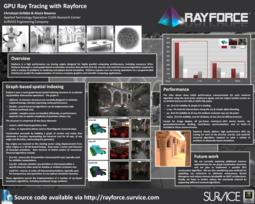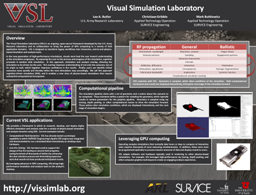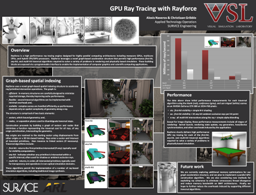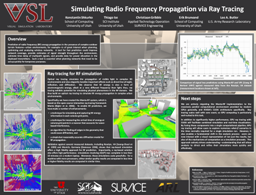2018
 |
|
Autonomous Precision Landing for the Joint Tactical Aerial Resupply Vehicle
Shawn Recker, Christiaan Gribble, and Mark Butkiewicz
Applied Imagery Pattern Recognition Workshop,
October 2018
We discuss the precision autonomous landing features
of the Joint Tactical Aerial Resupply Vehicle (JTARV)
platform. Autonomous navigation for aerial vehicles
demands that computer vision algorithms provide not
only relevant, actionable information, but that they
do so in a timely manner—i.e., the algorithms
must operate in real-time. This requirement for high
performance dictates optimization at every level,
which is the focus of our on-going research and
development efforts for adding autonomous features to
JTARV. Autonomous precision landing capabilities are
enabled by high-performance deep learning and
structure-from-motion techniques optimized for NVIDIA
mobile GPUs. The system uses a single downward-facing
camera to guide the vehicle to a coded photogrammetry
target, ultimately enabling fully autonomous aerial
resupply for troops on the ground. This paper details
the system architecture and perception system design
and evaluates performance on a scale vehicle. Results
demonstrate that the system is capable of landing on
stationary targets within relatively narrow spaces.
|
|
|
|
|
 |
|
Implementing Node Culling Multi-Hit BVH Traversal in Embree
Christiaan Gribble
JCGT paper presentation, ACM SIGGRAPH Symposium on Interactive 3D Graphics and Games,
May 2018
We present the Journal of Computer Graphics
Techniques paper entitled "Implementing Node
Culling Multi-Hit BVH Traversal in Embree." After a
brief introduction to multi-hit ray traversal, we
motivate the node culling algorithm and highlight the
implementation trick required to induce node culling
for more efficient multi-hit ray tracing with both
Intel's Embree CPU ray tracing kernels (as originally
discussed in the JCGT paper) and NVIDIA's OptiX GPU
ray tracing engine. Results show that node culling
offers potentially significant improvement in
multi-hit performance in a BVH for cases in which
users request fewer-than-all hits.
Additional
resources, including the paper's full text,
supplemental materials, and source code, are also
available.
|
2017
 |
|
RckT:
Scalable Physically Accurate Spectral Rendering in OSPRay
Christiaan Gribble
Technical session, Intel HPC Developer Conference,
November 2017
We discuss RckT, a scalable physically accurate
spectral rendering system that builds on OSPRay,
Intel's high fidelity visualization framework. After
a brief review of RckT's goals and some possible
applications, we discuss the design and
implementation of our spectral rendering components in
OSPRay using the Intel SPMD Program Compiler, ispc.
We then demonstrate our spectral rendering
implementation by using RckT for fast and accurate
visualization of complex scenes. In this application,
RckT is used directly for visualization, demonstrating
the utility of OSPRay as a basis for high performance,
high fidelity rendering of complex models. RckT
showcases OSPRay as an extensible framework in which
to implement ray based rendering techniques supporting
scalable, high performance visual analysis tools
across several domains.
|
|
|
|
|
 |
|
Real-Time,
In Situ Intelligent Video Analytics for Mobile Platforms
Christiaan Gribble
Technical session, GPU Technology Conference,
May 2017
We highlight Sentinel, a system for real-time in-situ
intelligent video analytics on mobile computing
platforms. Sentinel combines state-of-the-art
techniques in HPC with Dynamic Mode Decomposition
(DMD), a proven method for data reduction and
analysis. By leveraging CUDA, our early system
prototype achieves significantly better-than-real-time
performance for DMD-based background/foreground
separation on high-definition video streams, thereby
establishing the efficacy of DMD as the foundation on
which to build higher level real-time computer vision
techniques. In this talk, we present an overview of
the Sentinel system, including the application of DMD
to background/foreground separation in video streams,
and outline our ongoing efforts to enhance and extend
the prototype system.
A GTC
2017 poster
highlighting Sentinel is also available.
|
|
|
|
|
 |
|
Real-Time,
In Situ Intelligent Video Analytics: Harnessing the
Power of GPUs for Deep Learning Applications
Shawn Recker and Christiaan Gribble
DSIAC Journal, vol. 4, no. 1
Modern graphics processing units (GPUs), now
explicitly designed for deep learning algorithms, have
enabled many of the recent and impressive achievements
of contemporary deep learning techniques. At the same
time, these massively parallel architectures are
driving the next generation of deep learning
algorithms for intelligent video analytics (IVA). We
discuss contemporary approaches to deep learning and
highlight Sentinel, a system leveraging modern GPU
architectures and advances in deep learning to provide
real-time in situ IVA for applications in defense,
homeland security, emergency response, and disaster
relief, among others.
|
2016
 |
|
Implementing
Node Culling Multi-Hit BVH Traversal in Embree
Christiaan Gribble, Ingo Wald, and Jefferson
Amstutz
Journal of Computer Graphics Techniques,
vol. 5, no. 4
We present an implementation of node culling multi-hit
BVH traversal in Embree. Whereas previous work was
limited by API restrictions, as of version 2.10.0,
Embree respects ray state modifications from within
its intersection callbacks (ICBs). This behavior
permits an ICB-based implementation of the node
culling algorithm, but requires a clever trick to
induce culling once the necessary conditions are met:
candidate intersections are accepted with a (possibly)
modified tfar value, so that ray
traversal continues with an updated ray interval. We
highlight a scalar implementation of the Embree ICB
and report results for a vector implementation in
OSPRay that improves performance by as much as 2x
relative to naive multi-hit when users request
fewer-than-all hits.
Slides
for the paper presentation at ACM SIGGRAPH Symposium
on Interactive 3D Graphics and Games 2018 are also
available.
|
|
|
|
|
 |
|
Realizing
Multi-Hit Ray Tracing in Embree & OSPRay
Christiaan Gribble
Technical session, Intel HPC Developer Conference, November 2016
We discuss multi-hit ray traversal, a class of ray
traversal algorithms that finds one or more, and
possibly all, primitives intersected by a ray and
ordered by point of intersection. After a brief review
the multi-hit problem, we discuss the implementation of
high performance multi-hit ray traversal in
Embree—Intel's high performance ray tracing
kernels—and in OSPRay—Intel's ray based
rendering engine for high fidelity
visualization—using the Intel SPMD Program
Compiler, ispc. We then demonstrate our
implementation with two key applications:
- fast and accurate rendering of transparent objects
for high fidelity visualization, and
- a physics-based simulation in which the
interesting phenomena are governed by equations similar
to the Beer-Lambert Law.
In the first, our multi-hit ray tracing module for
OSPRay is used directly for visualization, demonstrating
the utility of OSPRay for high performance, high
fidelity visualization of complex engineering CAD
models. In the second, our module is used both for
simulation and for visualization, further demonstrating
OSPRay's flexibility. Both applications showcase OSPRay
as an extensible framework in which to implement
simulation and visualization techniques supporting
scalable, high performance visual analysis tools across
several domains.
|
|
|
|
|
 |
|
Real-Time
In-Situ Intelligent Video Analytics for Mobile Platforms
Christiaan Gribble
Technical session, GPU Technology Conference
Washington, D.C., October 2016
We highlight Sentinel, a system for real-time in-situ
intelligent video analytics on mobile computing
platforms. Sentinel combines state-of-the-art
techniques in HPC with Dynamic Mode Decomposition (DMD),
a proven method for data reduction and analysis. By
leveraging CUDA, our early system prototype achieves
significantly better-than-real-time performance for
DMD-based background/foreground separation on
high-definition video streams, thereby establishing the
efficacy of DMD as the foundation on which to build
higher level real-time computer vision techniques. In
this talk, we present an overview of the Sentinel
system, including the application of DMD to
background/foreground separation in video streams, and
outline our current efforts to enhance and extend the
prototype system.
|
|
|
|
|
 |
|
HawkEye:
Automatic Stitching of Hand-Held LIDAR Scans using
Photogrammetry and Structure-from-Motion
Shawn Recker, Rob Baltrusch, Christiaan
Gribble, and Mark Butkiewicz
Coordinate Metrology Systems Conference, July 2016
The reconstruction of a scene from multiple images or
video streams has become an essential component in many
modern applications. This paper presents a hand-held
consumer-grade optical scanner and supporting
application suite, called HawkEye. The fully automatic
reconstruction system is based upon advancements in
hybrid photogrammetry/structure-from-motion technologies
and produces a globally aligned 3D model. Analysis of
HawkEye results demonstrate visually accurate scene
reconstructions.
|
|
|
|
|
 |
|
Node Culling
Multi-Hit BVH Traversal
Christiaan Gribble
Eurographics Symposium on Rendering (EI&I
track), June 2016
We introduce node culling multi-hit BVH traversal to
enable faster multi-hit ray tracing in a bounding volume
hierarchy (BVH). Existing, widely used ray tracing
engines expose API features that enable implementation
of multi-hit traversal without modifying their
underlying—and highly optimized—BVH
construction and traversal routines; however, this
approach requires naive multi-hit traversal to guarantee
correctness. We evaluate two low-overhead, minimally
invasive, and flexible API mechanisms that enable node
culling implementation entirely with user-level code,
thereby leveraging existing BVH construction and
traversal routines. Results show that node culling
offers potentially significant improvement in multi-hit
performance in a BVH for cases in which users request
fewer-than-all hits.
Supplemental
materials, including source code for
the reference implementation, are also
available.
Unless otherwise stated directly in the source, the code
is distributed under the BSD 3-Clause License
(see LICENSE for more
information). Instructions for building and running
the mhBVH driver program are available in
the README.
|
2015
 |
|
An
Evaluation of Multi-Hit
Ray Traversal in a BVH using Existing First-Hit/Any-Hit
Kernels
Jefferson Amstutz, Christiaan Gribble, Johannes
Gunther, and Ingo Wald
Journal of Computer Graphics Techniques,
vol. 4, no. 4
We explore techniques for multi-hit ray tracing in a
bounding volume hierarchy (BVH) using existing ray
traversal kernels and intersection callbacks. BVHs are
problematic for implementing multi-hit ray traversal
correctly due to the potential for spatially
overlapping leaf nodes. We demonstrate that the
intersection callback feature of modern, high
performance ray-tracing APIs enable correct and
efficient implementation of multi-hit ray tracing
despite this concern. Moreover, the callback-based
approach enables multi-hit ray tracing using existing,
highly optimized BVH data structures, mitigating
maintenance issues imposed by hand-tuned multi-hit
traversal kernels across various hardware
architectures. Results show that memory-bandwidth
limitations and SIMD vector width of the target
hardware platform dictate ideal hit-point memory
layout, as well as the point at which sorting should
occur, in order to maximize performance with existing
BVH traversal algorithms.
Slides
for the paper presentation at ACM SIGGRAPH Symposium
on Interactive 3D Graphics and Games 2016 are also
available.
|
|
|
|
|
 |
|
Effective
Parallelization Strategies for Scalable, High
Performance Radio Frequency Ray Tracing
Christiaan Gribble and Jefferson Amstutz
IEEE High Performance Extreme Computing,
September 2015
We present StingRay, an interactive environment for
combined RF simulation and visualization based on ray
tracing. StingRay is explicitly designed to support
scalable, high performance simulation and
visualization of RF energy propagation in complex
urban environments using modern, highly parallel
computer architectures. We explore three strategies
for exploiting parallelism in StingRay and provide
evaluations of their scalability and performance on a
modern workstation-class system. Results show that a
more scalable, higher performing version of StingRay
is possible with careful attention to the expression
of task-level parallelism in OpenMP.
|
|
|
|
|
 |
|
Radio
Frequency Ray Tracing
Christiaan Gribble and Jefferson Amstutz
Book chapter, High Performance Parallelism
Pearls, Volume 2, July 2015
Radio frequency simulation and visualization is
critical to planning, analyzing, and optimizing
wireless communication networks. An interactive tool
supporting visual analysis of RF propagation
characteristics in complex environments will enable
analysts to better understand RF propagation
phenomena. We discuss StingRay, an interactive
combined RF simulation and visualization environment
that satisfies these constraints. Derived from first
principles, StingRay's ray-based RF simulation engine
provides a high fidelity approach for RF prediction in
complex environments. StingRay is explicitly designed
for Intel Xeon processors and Intel Xeon Phi
coprocessors, which provide high performance compute
capabilities for physics based simulation. In this
way, StingRay combines best-known methods in high
performance ray tracing and high fidelity
visualization with low-level, architecture-specific
optimizations for Intel Xeon processors and Intel Xeon
Phi coprocessors to provide an interactive environment
for predictive simulation and visualization of RF
energy propagation in complex environments.
|
|
|
|
|
 |
|
An
Evaluation of Existing BVH Traversal Algorithms for Efficient
Multi-Hit Ray Tracing
Jefferson Amstutz, Johannes Guenther, Ingo Wald,
and Christiaan Gribble
Poster, ACM SIGGRAPH/Eurographics High
Performance Graphics, July 2015
We explore techniques for multi-hit ray tracing in a
bounding volume hierarchy (BVH). BVHs are problematic
for implementing multi-hit ray traversal correctly due
to the potential for spatially overlapping leaf
nodes. We demonstrate that the intersection callback
feature of modern, high performance ray tracing APIs
enables correct and efficient implementation of
multi-hit ray tracing despite this concern. Moreover,
the callback-based approach enables multi-hit ray
tracing using existing, highly optimized BVH data
structures, mitigating maintenance issues imposed by
hand-tuned multi-hit traversal kernels across various
hardware architectures. Results show that memory
bandwidth limitations and SIMD vector width of the
target hardware platform dictate ideal hit point
memory layout, as well as the point at which sorting
should occur, to maximize performance with existing
BVH traversal algorithms.
An extended
abstract for the poster and
slides
for the corresponding quick talk are also
available.
|
|
|
|
|
 |
|
StingRay:
High-Performance RF Energy Propagation Modeling in
Complex Environments
Christiaan Gribble and Jefferson Amstutz
DSIAC Journal, vol. 2, no. 2
StingRay is an interactive environment for combined
radio frequency (RF) simulation and visualization
using ray tracing. RF ray tracing offers an
alternative to traditional RF simulation methods, and
provides several advantages over these methods.
StingRay leverages these advantages to provide highly
interactive visual analysis of RF propagation
characteristics. StingRay achieves high performance
RF simulation by leveraging Intel's Embree ray tracing
kernels, and Intel's OSPRay rendering engine provides
high fidelity visualization of the resulting data. We
show that StingRay enables high performance, high
fidelity combined simulation and visualization of RF
energy propagation, providing the ability to quickly
identify phenomena of interest, thereby reducing
time-to-insight for many mission planning tasks.
|
|
|
|
|
 |
|
Leveraging
GPUs for Ballistic Simulation
Jefferson Amstutz and Christiaan Gribble
DSIAC Journal, vol. 2, no. 1
Massively parallel coprocessors, specifically graphics
processing units (GPUs), are becoming increasingly
popular as a means to accelerate computation.
However, the ballistic simulation community has seen
relatively little adoption of GPUs into their
workflows, due in part to the complexity of mapping
existing codes to these devices. We discuss a new
software architecture for ballistic simulation that
effectively exploits GPUs, resulting in the ability to
execute simulations in real-time on a single
workstation.
|
2014
 |
|
High
Performance Radio Frequency Ray Tracing with Embree
Christiaan Gribble and Jefferson Amstutz
Technical session, Intel HPC Developer
Conference, November 2014
Predictive simulation and visualization of radio
frequency (RF) energy propagation is critical to
planning, analyzing, and optimizing wireless
communication networks. RF ray tracing (RFRT) is an
alternative to traditional RF simulation methods that
offers several advantages over these methods. First,
implementation of ray-based RF energy transport is
fairly straightforward. Second, RFRT generates full
signal trajectories, allowing computation and
visualization of signal characteristics that are
extremely costly, or even impossible, with other
methods. Finally, RFRT scales effectively, both with
geometric complexity and with core count.
This talk presents the details of StingRay, an
interactive environment for combined RF simulation and
visualization. High performance RF simulation is
achieved by leveraging Intel's Embree ray tracing
kernels, and Intel's OSPRay rendering engine provides
high fidelity visualization of the resulting data. We
show that, together, StingRay, Embree, and OSPRay
enable high performance, high fidelity combined
simulation and visualization of physical phenomena in
non-optical domains, including RF energy propagation.
An abbreviated
version of this talk is also featured in
the Intel Parallel Universe Theater, part of
the Supercomputing 2014 Exhibition.
|
|
|
|
|
 |
|
Depth Data
Assisted Structure-from-Motion Parameter Optimization
and Feature Track Correction
Shawn Recker, Christiaan Gribble, Mikhail
M. Shashkov, Mario Yepez, Mauricio Hess-Flores, and
Kenneth I. Joy
Applied Imagery Pattern Recognition Workshop,
October 2014
Structure-from-Motion (SfM) applications attempt to
reconstruct the three-dimensional (3D) geometry of an
underlying scene from a collection of images, taken
from various camera viewpoints. Traditional
optimization techniques in SfM, which compute and
refine camera poses and 3D structure, rely only on
feature tracks, or sets of corresponding pixels,
generated from color (RGB) images. With the abundance
of reliable depth sensor information, these
optimization procedures can be augmented to increase
the accuracy of reconstruction. This paper presents a
general cost function, which evaluates the quality of
a reconstruction based upon a previously established
angular cost function and depth data estimates. The
cost function takes into account two error measures:
first, the angular error between each computed 3D
scene point and its corresponding feature track
location, and second, the difference between the
sensor depth value and its computed estimate. A
bundle adjustment parameter optimization is
implemented using the proposed cost function and
evaluated for accuracy and performance. As opposed to
traditional bundle adjustment, in the event of feature
tracking errors, a corrective routine is also present
to detect and correct inaccurate feature tracks. The
filtering algorithm involves clustering depth
estimates of the same scene point and observing the
difference between the depth point estimates and the
triangulated 3D point. Results on both real and
synthetic data are presented and show that
reconstruction accuracy is improved.
|
|
|
|
|
 |
|
Hybrid
Photogrammetry Structure-from-Motion Systems for Scene
Measurement and Analysis
Shawn Recker, Mikhail M. Shashkov, Mauricio
Hess-Flores, Christiaan Gribble, Rob Baltrusch, Mark
A. Butkiewicz, and Kenneth I. Joy
Coordinate Metrology Systems Conference,
July 2014
Given the recent advances in both photogrammetry and
structure-from-motion, a pipeline that capitalizes on
the strengths of both fields is now possible. This
paper presents a hybrid system that uses
photogrammetric information to improve the accuracy of
structure-from-motion, which in turn provides a more
dense reconstruction. The procedure maintains the
required metrological accuracy and permits
measurements between points with no corresponding
targets. The paper provides an analysis of the
effects of various camera parameters to determine
optimal scene configurations. Results generated by
the hybrid system for real and synthetic data
demonstrate that both more accurate and more dense
reconstructions are obtained than with
structure-from-motion alone.
This paper also appears as a feature article
in CMSC World, 13 November 2014.
|
|
|
|
|
 |
|
Multi-Hit
Ray Traversal
Christiaan Gribble, Alexis Naveros, and Ethan
Kerzner
Journal of Computer Graphics Techniques,
vol. 3, no. 1
Multi-hit ray traversal is a class of ray
traversal algorithms that finds one or more, and
possibly all, primitives intersected by a ray ordered
by point of intersection. Multi-hit
traversal generalizes traditional first-hit
ray traversal and is useful in computer graphics and
physics-based simulation. We introduce an efficient
algorithm for ordered multi-hit ray
traversal, investigate its performance in a GPU ray
tracer, and demonstrate two problems easily solved
with our algorithm.
Slides
for the paper presentation at ACM SIGGRAPH Symposium
on Interactive 3D Graphics and Games 2014 are also
available.
|
2013
 |
|
Ray
Tracing is the Future and Ever Will Be...
Alexander Keller, Ingo Wald, Tero Karras, Samuli
Laine, Jacco Bikker, Christiaan Gribble, Won-Jong Lee,
and James McCombe
Course, ACM SIGGRAPH, July 2013
The primary objective of this course is to present a
coherent summary of the state of the art in ray tracing
technology. The course covers the most recent
developments and practical aspects of the parallel
construction of acceleration data structures and
traversal of such acceleration data structures using
highly parallel processors, including a discussion of
divergent code paths and memory accesses as well as
occupancy. Ray tracing in real-time games is considered
one of the main application opportunities, but an
important part of the course focuses on hardware for ray
tracing applications in mobile platforms.
|
|
|
|
|
 |
|
GPU Ray
Tracing with Rayforce
Christiaan Gribble and Alexis Naveros
Poster,
ACM SIGGRAPH, July 2013
Rayforce is a high performance ray tracing engine
designed for massively parallel computing architectures,
including manycore GPUs. Rayforce leverages a novel
graph-based acceleration structure that permits
first-hit, any-hit,
and multi-hit traversal algorithms required to
solve a variety of problems in physics-based simulation
domains. Rayforce exposes core ray tracing operations
via a programmable interface to enable the
implementation of various computer graphics and
scientific computing applications.
An extended
abstract for the poster is also
available.
|
|
|
|
|
 |
|
Toward
Accurate and Efficient Order-Independent Transparency
Ethan Kerzner, Chris Wyman, Lee Butler, and
Christiaan Gribble
Poster,
ACM SIGGRAPH, July 2013
Correctly rendering multi-layered transparent geometry
requires accumulating contributions from multiple
fragments per pixel. Dynamic A-buffers (e.g., per-pixel
linked lists [Yang et al. 2010]) achieve this by storing
and sorting fragments on-the-fly. We introduce an
improvement to recent GPU-based interactive A-buffer
techniques: we decouple visibility and shading to reduce
memory demands of multi-fragment rendering.
An extended
abstract for the poster is also
available.
|
|
|
|
|
 |
|
Advances
in High-performance GPU Ray Tracing for Physics-based
Simulation
Christiaan Gribble and Lee Butler
Technical session,
GPU Technology Conference, March 2013
Explore recent advances in high-performance GPU ray
tracing for applications other than optical
rendering. In this session, we dive into the details of
Rayforce, a CUDA ray tracing engine that leverages a new
graph-based spatial indexing structure to achieve
performance in excess of one billion rays per second in
some non-trivial scenarios. We then explore several
example applications that leverage Rayforce in a
framework for cognition-driven simulation (CDS) that
enables analysts to experience an immersive
physics-based simulation environment. Compared to
traditional means of analysis, CDS represents a
next-generation approach to simulation and analysis
across a broad range of application domains.
|
|
|
|
|
 |
|
Visual
Simulation Laboratory
Lee Butler, Christiaan Gribble, and Mark
Butkiewicz
Poster,
GPU Technology Conference, March 2013
The Visual Simulation Laboratory (VSL) is an ongoing,
open-source framework developed by the U.S. Army
Research Laboratory and its collaborators to bring the
power of GPU computing to a variety of DoD application
domains. VSL is designed to transform legacy workflows
into immersive, end-to-end physics-based simulation and
analysis tools.
In the new generation of high-performance simulations,
visuals must lead the user toward understanding as the
simulation progresses. By exposing the user to the
process and progress of the simulation, cognition
proceeds in tandem with simulation. In this approach,
simulation and analysis overlap, allowing the simulation
to be driven by the user. This overlap improves
understanding of not only the outcome, but of its origin
as well, which together improves confidence in the
results. Finally, users can identify critical outcomes
more quickly and thereby refine the next stimulation
step accordingly. We call this approach cognition-driven
simulation (CDS), and it enables a new class of
physics-based simulations that require substantial
computational horsepower.
|
|
|
|
|
 |
|
GPU
Ray Tracing with Rayforce
Alexis Naveros and Christiaan Gribble
Poster,
GPU Technology Conference, March 2013
Rayforce is a high performance ray tracing engine
designed for highly parallel computing architectures
including manycore GPUs, multicore CPUs, and hybrid
CPU/GPU processors. Rayforce leverages a novel
graph-based acceleration structure that permits
high-performance first-hit, any-hit,
and multi-hit traversal algorithms required to
solve a variety of problems in rendering and physically
based simulation. These building blocks are exposed via
a programmable interface to enable the implementation of
computer graphics and scientific computing
applications.
|
|
|
|
|
 |
|
Simulating
Radio Frequency Propagation via Ray Tracing
Konstantin Shkurko, Thiago Ize, Christiaan
Gribble, Erik Brunvand, and Lee Butler
Poster,
GPU Technology Conference, March 2013
Prediction of radio frequency (RF) energy propagation in
the presence of complex outdoor terrain features—urban
environments, for example—is of great interest when
planning, optimizing and analyzing wireless networks. A
tool for fast prediction could improve network coverage,
provide estimates of signal strength throughout the
environment, estimate time delay of multipath signals,
and provide data for power allocation in the deployed
transmitters. Such a tool is essential when planning
networks that need to be set up quickly for temporary
purposes.
|
[ 2001-2006 ]
[ 2007-2012 ]
[ 2013-2018 ]
[ 2019-present ]
|
| | | |

